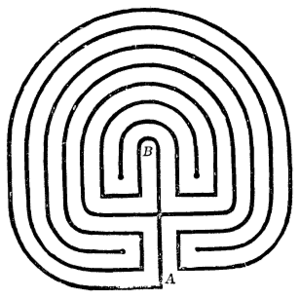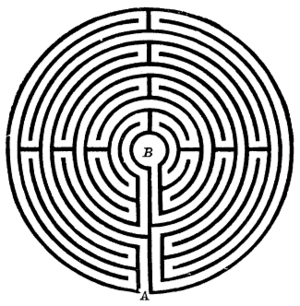Turf maze facts for kids
A turf maze is a special type of labyrinth created by cutting a winding path into a flat area of short grass. Imagine a giant puzzle carved into the ground! These mazes have been known by many names, like Mizmaze, Troy Town, The Walls of Troy, Julian's Bower, or Shepherd's Race.
Even famous writers like William Shakespeare knew about them. In his play A Midsummer Night's Dream, a character named Titania talks about how these "quaint mazes" become hard to see when people don't walk on them.
In some turf labyrinths, the path you walk on is the groove cut into the grass. Sometimes these grooves are even filled with bricks or gravel. More often, the grassy parts themselves form the raised path, and the shallow channels between them are where you can't step.
Most turf mazes in Britain follow one of two main designs: the older Classical pattern or the more complex Medieval type that came later.
Contents
Where Did Turf Mazes Come From?
The very first known use of the classical labyrinth pattern in the British Isles is on the Hollywood Stone in Ireland, dating back to around 550 AD. There are also two small classical labyrinths carved into a cliff face near Tintagel, Cornwall. People aren't sure exactly how old these are, with guesses ranging from the Bronze Age to the 17th century!
It's tricky to know the exact age of a turf maze because they need to be re-cut often to keep their designs clear. This regular upkeep can disturb any old clues that archaeologists might find. So, a maze could be much older than its first written record.
Historically, turf mazes were mostly found in Northern Europe, especially England, Germany, and Denmark. Many similar labyrinths exist in Scandinavia, Lappland, Iceland, and parts of the former Soviet Union. However, their paths were usually marked with stones, either on grass or bare rock. Some of these stone labyrinths are very, very old.
In recent times, people have become interested in mazes and labyrinths again. This has led to new turf mazes being built in the United States and Europe. Some are very large and might even include wild flowers or scented herbs between the paths. Modern designs often use paved paths to make them last longer and stay clear.
What Were Turf Mazes Used For?
People have wondered a lot about why turf mazes were made and what they were used for. Many English examples look like the pavement mazes found in old cathedrals in Europe, like Chartres. Because of this, some believe they were used by people doing penance, walking the paths on their hands and knees. However, there's no clear proof for this idea.
Some turf mazes were near religious places like churches or abbeys, but others were not.
Many mazes were on village greens and were popular for fun, especially for children and young people during holidays. For example, the maze at Alkborough was used for games on May Eve in the early 1800s. At Boughton Green, "treading the maze" was part of a three-day fair held in June.
Large turf mazes in Germany and Poland were used for special parades during Whitsuntide or as part of May celebrations.
Many stone labyrinths around the Baltic coast of Sweden were built by fishermen during bad weather. They believed these mazes could trap evil spirits called "smågubbar" or "little people" who brought bad luck. The fishermen would walk to the center of the labyrinth, hoping the spirits would follow, then run out quickly and go to sea.
Today, new turf mazes are made for different reasons. Some are private and used for quiet thinking or meditation, similar to how a mandala might be used. Others are popular tourist attractions.
Names of Mazes
Several English turf mazes were called "Troy," "Troy Town," or "The Walls of Troy." In Wales, where shepherds cut these patterns into hilltops, they were known as "Caerdroia." Sadly, no old Welsh examples still exist. "Caer" means wall, castle, or city, so "Caerdroia" means "City of Troy." Legend says the walls of the city of Troy were built so confusingly that enemies couldn't find their way out.
Other common maze names like "Julian's Bower" and "St Julian's" might come from Julius, a son of Aeneas from Troy, and the word burgh, which also means a fortified place.
The Troy connection is also found in the names of stone-lined mazes in Scandinavia, like Trojaborg near Visby in Sweden. In Denmark, where there used to be many turf mazes, names like "Trojborg" or "Trelleborg" were common.
Some German turf maze names suggest a link with Sweden, such as "Schwedenhieb" (Swede's cut) or "Schwedengang" (Swede's path). Local stories connect them to Swedish officers buried during the Thirty Years' War (1618–48), but many believe they are much older.
At Stolp in Pomerania, Poland, a processional turf labyrinth called "Windelbahn" ("coil-track") was used by the Shoemakers' Guild. The original was destroyed, but a copy was made in 1935.
Old Turf Mazes Still Around
It's hard to date turf mazes because they need to be re-cut often. However, eight supposedly ancient turf mazes are still found in England:
- Alkborough, North Lincolnshire: "Julian's Bower" (mentioned around 1700).
- Breamore, Hampshire: "Miz-Maze."
- Dalby, North Yorkshire: "City of Troy," said to be the smallest turf maze in Europe.
- Hilton, Cambridgeshire (cut in 1660).
- Saffron Walden, Essex (re-cut in 1699; its path is a narrow groove, marked with bricks in 1911).
- Troy Farm, Somerton, Oxfordshire: "Troy."
- St. Catherine's Hill, Hampshire, near Winchester: "Miz-Maze" (an unusual square design with a narrow groove path).
- Wing, Rutland: "The Old Maze."
The mazes in Alkborough, Breamore, Hilton, and Wing share the same design as the one found in Chartres Cathedral. The Saffron Walden maze has four pointed corners, sometimes called the "Super Chartres" design. The mazes in Somerton and Dalby are of the "Classical" design, similar to those seen on ancient coins from Crete.
There are also two places in the Isles of Scilly where several labyrinths have paths outlined with stones, like those in Scandinavia:
- Camperdizil Point, St Agnes.
- St Martin's.
Lost British Turf Mazes
Many turf mazes that once existed in Britain are now gone. According to a book by W.H. Matthews from 1922, these include:
- Appleby, Lincolnshire: "Troy's Walls."
- Asenby, North Yorkshire: Was still there but "ruinous" in 1908.
- Ashwell: Mentioned in the 1700s.
- Boughton Green, near Boughton, Northamptonshire: "Shepherd Ring" or "Shepherd's Race." It was destroyed by soldiers digging trenches during World War I.
- "Troy-town" near Dorchester, Dorset.
- Dover's Hill near Chipping Campden, Gloucestershire.
- "Maiden Bower" near Dunstable, Bedfordshire.
- Edenbridge, Kent: Maps show a "Troy Town" and "Troy Lane."
- Goathland, North Yorkshire: "July Park" or "St Julian's."
- Horncastle, Lincolnshire: "Julian Bower."
- Pimperne, Dorset: "Troy-town." This one had a unique design but was ploughed up in 1730.
- Ripon, North Yorkshire: Had an unusual spiral center but was ploughed up in 1827.
- Sneinton, Nottinghamshire: "Robin Hood's Race" or "Shepherd's Race." This one also had an unusual design but was ploughed up in 1797.
It's thought that there might have been as many as 80 to 100 turf mazes in Britain at one time.
Old Turf Mazes in Europe
- Eilenriede forest, near Hanover, Germany: "Das Rad" ("The Wheel"). This maze has been around since at least 1642.
- Graitschen, near Camburg, Thuringia, Germany: "Schwedenhieb" or "Schwedenring."
- Steigra, near Querfurt, Saxony-Anhalt, Germany: "Schwedengang" or "Trojaburg."
- Tibble near Anundshög, Västerås, Sweden: "Trojienborg" (named on a map from 1764).
Some Modern Turf Mazes
(Keep in mind that not all of these are open to the public).
- Greensboro, Vermont, USA (built in 1986).
- "Archbishop's Maze" Grey's Court, Henley-on-Thames, Oxfordshire, England (built in 1981, with brick paths).
- Chenies Manor House, Chenies, Buckinghamshire, England (built in 1983, based on an old painting).
- "Earth and Wild Flower Labyrinth," Tapton Park, Chesterfield, Derbyshire, England (built in 1996; possibly the largest classical labyrinth in the world).
- Navano, California, USA (built in 1987).
- Cloisters of Norwich Cathedral, Norwich, Norfolk, England (built in 2002, with grass paths marked by stone).
- Rose Hill Quarry, Swansea, Wales (built in 1987, with gravel paths).
- Rosehill Park, Rawmarsh, South Yorkshire (a small maze with gravel paths, 2010).
- Oak Lane, Rougham, near Bury St Edmunds, Suffolk, England (built in 1998).
- Norton Museum of Art, West Palm Beach, Florida, USA (built in 1997).
- "Seaton Millennium Labyrinth" Seaton, Devon, England (2005).
- Tofte Manor, Sharnebrook, Bedfordshire, England (a copy of the Chartres maze, built in 2004).
- Solsbury Hill, Bath, Somerset, England (cut in the mid-1990s as a protest).
- Stoke Newington, Hackney, London, England (open to the public at West Hackney Recreation Ground, 2014).
- Cathedral of The Isles, on Isle of Cumbrae, Scotland, has a turf maze next to the cathedral.
Images for kids
-
The turf maze at Wing in Rutland
-
Julian's Bower, Alkborough, North Lincolnshire











